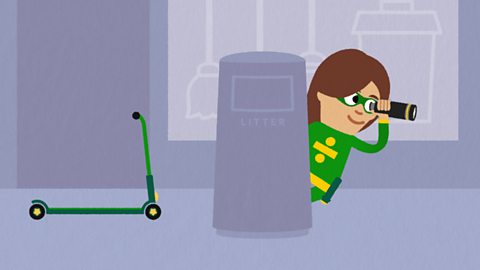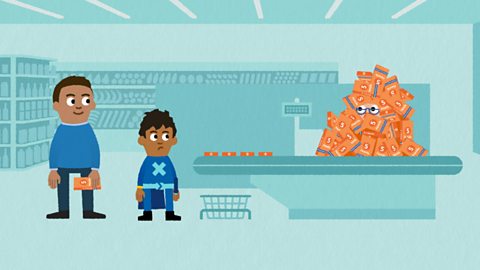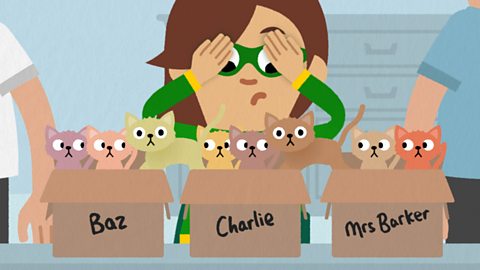Voiceover:
In a world without maths,a land where people forgot, who will save the day?
Dave:
And the winner of this year’s ‘Guess the number competition’ is Charlie.Well done, you guessed twenty five balloons, that was bang on. There you go, they’re all yours.
Mr Sharma:
Ooo twenty five, that was a good guess. I guessed two.
Mrs Sharma:
I guessed ninety nine and a half. Oh well, what will you do with all those balloons Charlie?Charlie?
Mr Sharma:
What are you doing up there?Jump down son, we’ll catch you.
Charlie:
I’m not letting go of the balloons.
Mrs Sharma:
Don’t be afraid, we’ll catch you.
Charlie:
I’m not letting go, these balloons are mine. I’m a winner.
Mrs Sharma:
Charlie Sharma get yourself down here right now.
Charlie:
I’m a winner!
Mrs Sharma:
Oh, how do we get him down? Twenty five balloons is too many for him to hold.
Mr Sharma:
We could pop them.
Mrs Sharma:
SIGH
Dave:
We could share them out. If everyone takes somewe can help him carry them home.
Mrs Sharma:
That’s a much better idea Dave. Charlie?
Charlie:
Yeah, okay.
Mrs Sharma:
Right so ninety nine and a half balloons shared out…no that’s not right…
Charlie:
Muuuum, you can’t do it. We need…Divider Girl.
Dave:
How you doing up there kid?
Charlie:
It’s a bit high, can I come down?
Mrs Sharma:
Divider Girl can you help? We need to share out Charlie’s balloons evenly, so we can get him off the ceiling.
Narrator:
This calls for quick thinking Divider Girl. There’s five of you altogether. How many balloons are there?
Charlie:
There’s twenty five balloons, I won twenty five balloons. I’m a winner! Help me!
Narrator:
It’s division time.
Twenty five balloons to be shared equally between five people.That’s twenty five divided by five.Can you do that in your head? Good thinking, using your number line you can count back in groups of five.Oh no, no number line!
Can you think of any other way to divide twenty five by five? Do you know your fives?There’s five people to share the balloons between. By counting up in fives to twenty five Divider Girl can work out how many fives there are in twenty five.Ready Divider Girl?
5, 10, 15, 20, 25. How many have you got there Divider Girl? Five.Five lots of five is twenty five. Division is the inverse of multiplication, so twenty five divided by five equals five.
Great work Divider Girl. Everyone gets five balloons each. Using multiplication facts has helped you to work out the division problem in your head.
Now let’s divide those balloons up. Twenty five minus five leaves twenty. Take away another five is fifteen, subtract another five leaves ten.
Now if Charlie gives Divider Girl five balloons,that leaves him with five balloons, so everyone will have five balloons each.
Twenty five divided by five equals five.
Charlie:
Thanks for rescuing me Divider Girl.You can keep the balloons everyone, five is enough for me.
Mr Sharma:
Hooray! Balloons for everyone.Awwww.
Thanks.
Video summary
Charlie has won a huge bunch of balloons; so huge they have put him in something of a precarious position.
But he’s not going to give them up easily.
He won them fair and square after all.
Dave suggests sharing them out, so they can all help him carry them home.
This sounds like a job for Divider Girl!
Divider Girl clambers to the rescue, but a fumble of her number line leaves her grasping for other options.
Can she help Charlie to share the balloons equally without it?
Can she use multiplication facts to help with this division problem?
Will Charlie ever get his feet back on the ground?
This clip is from the series A World Without Maths.
Teacher Notes
Key Stage 1:
Children could act out sharing balloons equally, like Charlie in the story.
Or use other objects to share equally between each other.
Ask the children to carefully count out how many objects there are before they start.
If the children are not yet familiar with remainders, make sure that the number can be equally shared between the number of children in the group.
Children could also solve problems related to the story, using pictures or their multiplication facts.
Key Stage 2:
Children might solve division problems related to the story using their multiplication facts.
Encourage children to think about how many of a number make the total they are dividing.
For example, Charlie needs to arrange 36 chairs around 6 tables for the school party, how many chairs will he put at each table? How many 6s make 36? How many 6s are in 36?
This clip will be relevant for teaching Maths at KS1 and KS2 in England and Wales, and First and Second Level in Scotland.
Multiples of two, five and ten. video
Multiplication Boy and Divider Girl keep their maths superpowers sharp with a competition to count in twos, fives and tens.

Multiples of two, five and ten. video
Multiplication Boy and Divider Girl keep their maths superpowers sharp with a competition to count in twos, fives and tens.

How to use arrays to multiply. video
Multiplication Boy helps Mr Sharma buy pencils for the school, using arrays to multiply.

What is multiplication? video
Multiplication Boy uses repeated addition to help Dave work out how many bricks he needs to build a new wall for Mrs Sharma.

The relationship between multiplication and division. video
Baz and Dave use division and multiplication to solve a tricky problem with kittens.

Dividing using repeated subtraction. video
Divider Girl uses repeated subtraction to help Mrs Barker with a division problem involving some hungry pups.
